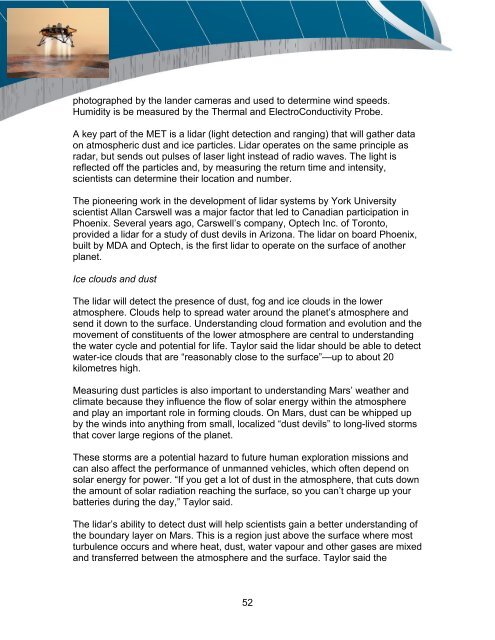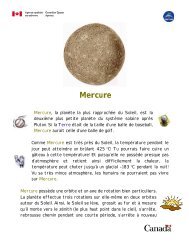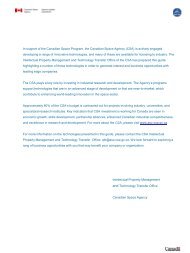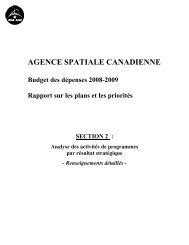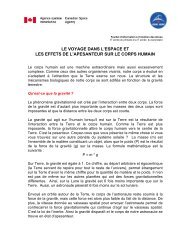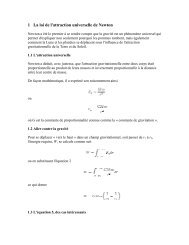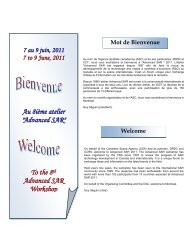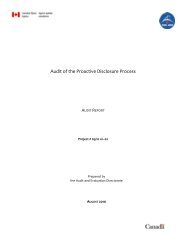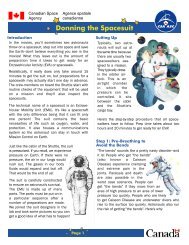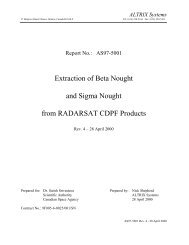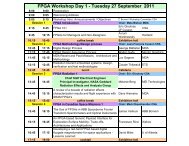PDF version of COSPAR - Space Science Research in Canada Report
PDF version of COSPAR - Space Science Research in Canada Report
PDF version of COSPAR - Space Science Research in Canada Report
You also want an ePaper? Increase the reach of your titles
YUMPU automatically turns print PDFs into web optimized ePapers that Google loves.
photographed by the lander cameras and used to determ<strong>in</strong>e w<strong>in</strong>d speeds.Humidity is be measured by the Thermal and ElectroConductivity Probe.A key part <strong>of</strong> the MET is a lidar (light detection and rang<strong>in</strong>g) that will gather dataon atmospheric dust and ice particles. Lidar operates on the same pr<strong>in</strong>ciple asradar, but sends out pulses <strong>of</strong> laser light <strong>in</strong>stead <strong>of</strong> radio waves. The light isreflected <strong>of</strong>f the particles and, by measur<strong>in</strong>g the return time and <strong>in</strong>tensity,scientists can determ<strong>in</strong>e their location and number.The pioneer<strong>in</strong>g work <strong>in</strong> the development <strong>of</strong> lidar systems by York Universityscientist Allan Carswell was a major factor that led to Canadian participation <strong>in</strong>Phoenix. Several years ago, Carswell’s company, Optech Inc. <strong>of</strong> Toronto,provided a lidar for a study <strong>of</strong> dust devils <strong>in</strong> Arizona. The lidar on board Phoenix,built by MDA and Optech, is the first lidar to operate on the surface <strong>of</strong> anotherplanet.Ice clouds and dustThe lidar will detect the presence <strong>of</strong> dust, fog and ice clouds <strong>in</strong> the loweratmosphere. Clouds help to spread water around the planet’s atmosphere andsend it down to the surface. Understand<strong>in</strong>g cloud formation and evolution and themovement <strong>of</strong> constituents <strong>of</strong> the lower atmosphere are central to understand<strong>in</strong>gthe water cycle and potential for life. Taylor said the lidar should be able to detectwater-ice clouds that are “reasonably close to the surface”—up to about 20kilometres high.Measur<strong>in</strong>g dust particles is also important to understand<strong>in</strong>g Mars’ weather andclimate because they <strong>in</strong>fluence the flow <strong>of</strong> solar energy with<strong>in</strong> the atmosphereand play an important role <strong>in</strong> form<strong>in</strong>g clouds. On Mars, dust can be whipped upby the w<strong>in</strong>ds <strong>in</strong>to anyth<strong>in</strong>g from small, localized “dust devils” to long-lived stormsthat cover large regions <strong>of</strong> the planet.These storms are a potential hazard to future human exploration missions andcan also affect the performance <strong>of</strong> unmanned vehicles, which <strong>of</strong>ten depend onsolar energy for power. “If you get a lot <strong>of</strong> dust <strong>in</strong> the atmosphere, that cuts downthe amount <strong>of</strong> solar radiation reach<strong>in</strong>g the surface, so you can’t charge up yourbatteries dur<strong>in</strong>g the day,” Taylor said.The lidar’s ability to detect dust will help scientists ga<strong>in</strong> a better understand<strong>in</strong>g <strong>of</strong>the boundary layer on Mars. This is a region just above the surface where mostturbulence occurs and where heat, dust, water vapour and other gases are mixedand transferred between the atmosphere and the surface. Taylor said the52


